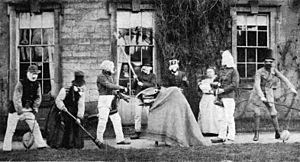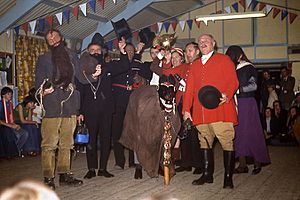Winster Guisers facts for kids
The Winster Guisers are a special group of people who perform a traditional play in the village of Winster, Derbyshire, UK. They usually perform during the Christmas holidays. Their play is based on a very old photograph taken around 1870. This photo shows some performers outside Winster Hall.
The Winster Guisers' play itself isn't from Winster. It's a play from Cheshire that was brought back to life in 1980. They chose this play because it includes a hobby horse, which is similar to one seen in the old photograph. A "guiser" is simply someone in disguise. In the Winster area, this word was often used for groups performing Christmas plays.
Contents
History of Winster Performances
In the mid-1800s, groups of guisers (or mummers) were very common in Derbyshire. They would perform in the week between Christmas and New Year. Records show that many groups visited Winster Hall in late December 1867.
The village of Winster also has a long history of morris dance. This type of dancing has been around for a long time, with records showing it existed in Winster by 1863. A famous person who studied old traditions, Cecil Sharp, visited Winster in 1908. He wrote down five different dances, including "The Processional" and "The Gallop."
Winster Morris Dancers
All the morris dancers are men or boys, dressed in white. A full team has 16 dancers. There are also four other characters, all played by men. These are the King and Queen, who lead the dancing. There is also the Jester (who used to be called the Fool) and the Witch. They entertain the crowd.
Cecil Sharp described them like this: "The dancers danced in procession … through the streets of Winster, stopping at certain places to perform one or two of their stationary dances. The King headed the procession, marching in step with the music … the Queen and the musician walked by the side of the dancers; the Fool and the Witch ran about clearing the way."
The Old Winster Hall Photograph
A famous photograph was taken at Winster Hall in Derbyshire around 1870. It shows a very unusual midwinter tradition with three hobby horses. The picture seems to have been taken in winter because the plants on the wall have no leaves.
There are eight or nine performers in the photo. Most of them have their faces covered or disguised. People believe this might be the oldest known photograph of a group of mummers or guisers.
Two men in military-style jackets and white trousers are riding small hobby horses. These horses are very unique. They have a round body, about three inches wide and two feet long. The rider holds the body between their legs. The horses also have a flat, curved wooden neck and a small head with snapping jaws. The horsemen's faces are covered with light-colored cloth.
The group is gathered around a "mast horse." This horse has a shiny black head made from a real skull. It has ears attached and a large eyeball painted white. The skull is on a short pole. A person crouches under a blanket behind the skull to operate it.
Behind this mast horse are two men who look like they are threatening it. One has a long stick, like a broom handle. The other has a besom broom (a type of broom). The man with the stick wears white trousers, a dark jacket, and a top hat. His face is hidden. The other man has a dark jacket and a fancy, flat-topped hat. He might be wearing a mask or have a painted beard.
Next to them is a woman in a long apron. She doesn't have her face covered. She might be a member of the household staff, not a performer. Another well-dressed person, possibly a servant, is looking out of a window in the door.
Another character wears a large, torn, dark dress with light-colored sleeves and a top hat. This person is busy sweeping the ground with a besom broom. This character reminds people of "Besom Bet" from some mummers plays or the Witch character from the Winster morris dance.
The last two characters are on the edges of the group. They are playing "rough music" on bladder fiddles. One has his face covered with a simple mask and wears a peaked cap. He has white trousers and a dark vest over a lighter, long-sleeved shirt. The other musician is dressed more smartly. He wears a top hat, a long riding jacket, breeches, knee-length socks or gaiters, and shiny shoes. He seems to have a fake beard and bushy eyebrows.
Mummers or Morris Dancers?
Some people think the performance in the photograph might have been a mumming play. However, others disagree because it doesn't show the usual fighting characters. Also, the two hobby horses are very unusual. The mast horse seems to be the main focus.
But, even without weapons, the two military-looking characters on hobby horses could be fighters. The two characters behind them, waving a pole and a broomstick, could also be involved in a mock fight. Also, a "Wild Horse" is a very important character in the "Soul-caking" plays from nearby Cheshire.
In 1908, Cecil Sharp mentioned a hobby horse connected to the Winster morris dance. He also talked about a "Snap Dragon" made from a real horse's skull. He didn't say if it was part of the morris dance. In 1966, Winster morris dancers said they never had a hobby horse with their dance. But they did have a separate horse ceremony involving a skull that was buried and dug up each year. It's possible that Sharp's "Snap Dragon" and the horse ceremony are the same tradition shown in the Winster Hall photograph.



